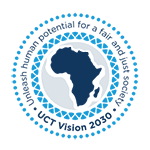Decomposing pig bodies provide insight into novel methods to identify human remains
20 March 2024 | Story Niémah Davids. Photo Robyn Walker. Read time 8 min.
As Kara Adams prepares to don her red robe and walk across the stage in the University of Cape Town’s (UCT) Sarah Baartman Hall – a landmark moment in her academic career – best believe she’s also preparing for a few gasps from the audience, and maybe (for some) even a jaw dropping moment as the topic of her “unconventional” PhD dissertation is announced.
Does it really get more unusual than a thesis titled: “The effect of clothing on decomposition and scavenging in two forensically significant habitats in Cape Town”? Well, for some, maybe, for others, definitely not! For Kara, forensic anthropology (studying and assisting to identify human skeletonised individuals from medico-legal death investigations) has long been a fascination, and her PhD graduation from UCT’s Department of Human Biology in the Faculty of Health Sciences means she comes full circle in her career.
“It’s an unbelievable feeling to finally be at the last stop and it’s taken a great deal of work to get here. But I firmly believe that with the right mindset we can achieve anything we set our minds to. Yes, challenges will come our way and when they do, we simply need to have the flexibility of mind to work through or around them,” she said.
A two-part research undertaking
Kara’s research forms part of UCT Professor Victoria Gibbon’s ongoing forensic taphonomic research, and it set out to uncover the effect clothing has on the body’s decomposition process. Considering South Africa’s high murder rate, Kara said identifying unidentified human remains is a big challenge, which means the forensic investigation is severely hamstrung. So, her research aimed to provide new insight into positively identifying human remains using cutting-edge technology. Because human bodies are not permitted for use in taphonomic research in South Africa, large pigs – the next best alternative – were used instead. Pigs are regularly used globally for human analogues because they are anatomically similar to human beings.
“My PhD research and the process that goes with it is an experience I wouldn’t trade for anything in the world.”
The research study included two parts. For the first, Kara collected forensically relevant data and incorporated six single, clothed porcine bodies, weighing 60 kg each, into her research methodology. She said the pigs were dressed in common clothing items used for local medico-legal cases. These season-specific items included underwear, cotton t-shirts, denim pants and leather belts, as well as socks, shoes and jerseys. Each piece of clothing was tailored to fit the six pigs and Kara examined their decomposition over a period of 18 months (between July 2021 and March 2023) to draw her conclusions.
“My PhD research and the process that goes with it is an experience I wouldn’t trade for anything in the world. It was fun and deeply insightful. I especially enjoyed the experimental fieldwork, which can be quite unpredictable at the best of times because it’s not always possible to anticipate challenges that arise. But I worked with an amazing team of people who really helped me along the way,” she said.
The decomposition process
Once she obtained the porcine bodies, Kara needed to examine the decomposition process. She placed two in a peri-urban habitat (Delft) and four in a suburban habitat (Rosebank) in Cape Town, during the summer and winter months. Each porcine body was placed on an autonomous weighing apparatus, developed and designed by her supervisors, Professor Gibbon and Dr Devin Finaughty, in partnership with the Department of Electrical Engineering’s Justin Pead. The apparatus automatically recorded the weight of each pig every evening, and cameras placed around the carcasses monitored any scavenging activities.
“These results advocate for using single, clothed porcine bodies, deployed across multiple seasonal trials in forensically significant locations to produce data that can be considered forensically realistic.”
Kara’s research findings indicate that the decomposition process was delayed significantly during the winter season and expedited in summer. This, she explained, also meant that clothing types and seasonality affect the decomposition process. Interestingly, on the peri-urban research site, she said, a Cape grey mongoose that scavenged the area also played an integral role in the porcine bodies’ quick decay.
“The scavenging by the Cape grey mongoose accelerated the decomposition process in Delft. In Rosebank there were no mongooses present, which means it took a lot longer for the porcine bodies there to start decomposing,” she said. “These results advocate for using single, clothed porcine bodies, deployed across multiple seasonal trials in forensically significant locations to produce data that can be considered forensically realistic.”
Precocious mummification
During the second part of her research undertaking, Kara used the porcine bodies to study precocious mummification (natural mummification that occurs in less than a month) – a unique phenomenon in the Western Cape. Printed computing boards were inserted into each carcass’s tissue to measure and record the tissue moisture content during 15-minute intervals. The results, she added, were then analysed using generalised additive modelling, which included environmental conditions like the temperature and rain to help her establish how environmental factors influence desiccation.
“This data collection demonstrates the potential of using accumulating degree days and moisture content to estimate the post-mortem interval.”
This leg of her research project was particularly special because it forms part of the first qualitative assessment of desiccation that has ultimately led to precocious mummification.
“This research provides valuable insights. Desiccation in summer appeared to follow an exponential decline and temperature was the most influential environmental factor. This data collection demonstrates the potential of using accumulative degree days and moisture content to estimate the post-mortem interval,” Kara said.
An automated field site
The cutting-edge technology used in this study was instrumental in reaching the array of research conclusions, which Kara described as a huge blessing, but at times also “a challenge”.
“We made use of numerous autonomous technological advances to collect the forensic taphonomic data at our sites. This was crucial as we move towards a more standardised method of data collection within the field. But as with trialling any new technology, there are always some challenges along the way. Thankfully, we could sort those all out,” she said.
“I can say that the practical experience that accompanied my research would not have been possible anywhere else in the world.”
A ‘rewarding’ experience
As Kara looks back on her PhD journey at UCT, she admits that running for the hills was something she contemplated at one point. The Canadian national was thousands of kilometres from home and often yearned for her family and a familiar environment.
“I registered in 2020, but because of the pandemic I couldn’t travel and so completed the first six months remotely. When I eventually got here, there was a point at the beginning of 2021 where all I wanted to do was go back home. It was at the height of the pandemic, Cape Town was still under strict lockdown restrictions and campus was closed. It was an incredibly isolating time. But I pressed on and made some wonderful friends both inside and outside of the programme,” she said.
Of her unconventional career path, Kara said her parents have been her biggest cheerleaders and offer unending support for her choices, which currently include taking up a postdoctoral research fellowship in UCT’s Department of Pathology. At her home away from home – UCT – Gibbon and Dr Finaughty have also provided the best support structure.
“It’s been a ride of a lifetime, but there have been so many characters in this chapter of my story who have contributed to its success.”
“It’s been a ride of a lifetime, but there have been so many characters in this chapter of my story who have contributed to its success, and for that my gratitude has no bounds,” Kara said.
 This work is licensed under a Creative Commons Attribution-NoDerivatives 4.0 International License.
This work is licensed under a Creative Commons Attribution-NoDerivatives 4.0 International License.
Please view the republishing articles page for more information.
Women’s Month 2024

UCT women in the news
Videos
#WomxnofUCT – social media elements
Customised Facebook and Instagram stickers are available on our social media platforms. Watch the tutorial videos here to see how easily you can get your online presence ready.
UCT women through the year

Professor Susan Cleary delivered her inaugural lecture on 14 March.
25 Mar 2024 - 5 min read









































